Contract Law: Elements of Contract Formation and Application of Law
VerifiedAdded on 2023/06/03
|9
|2327
|446
AI Summary
This article discusses the elements of contract formation and the application of law in contract disputes. It covers case laws and legal principles related to offer, acceptance, consideration, and good faith. The article also provides solutions to hypothetical contract disputes.
Contribute Materials
Your contribution can guide someone’s learning journey. Share your
documents today.
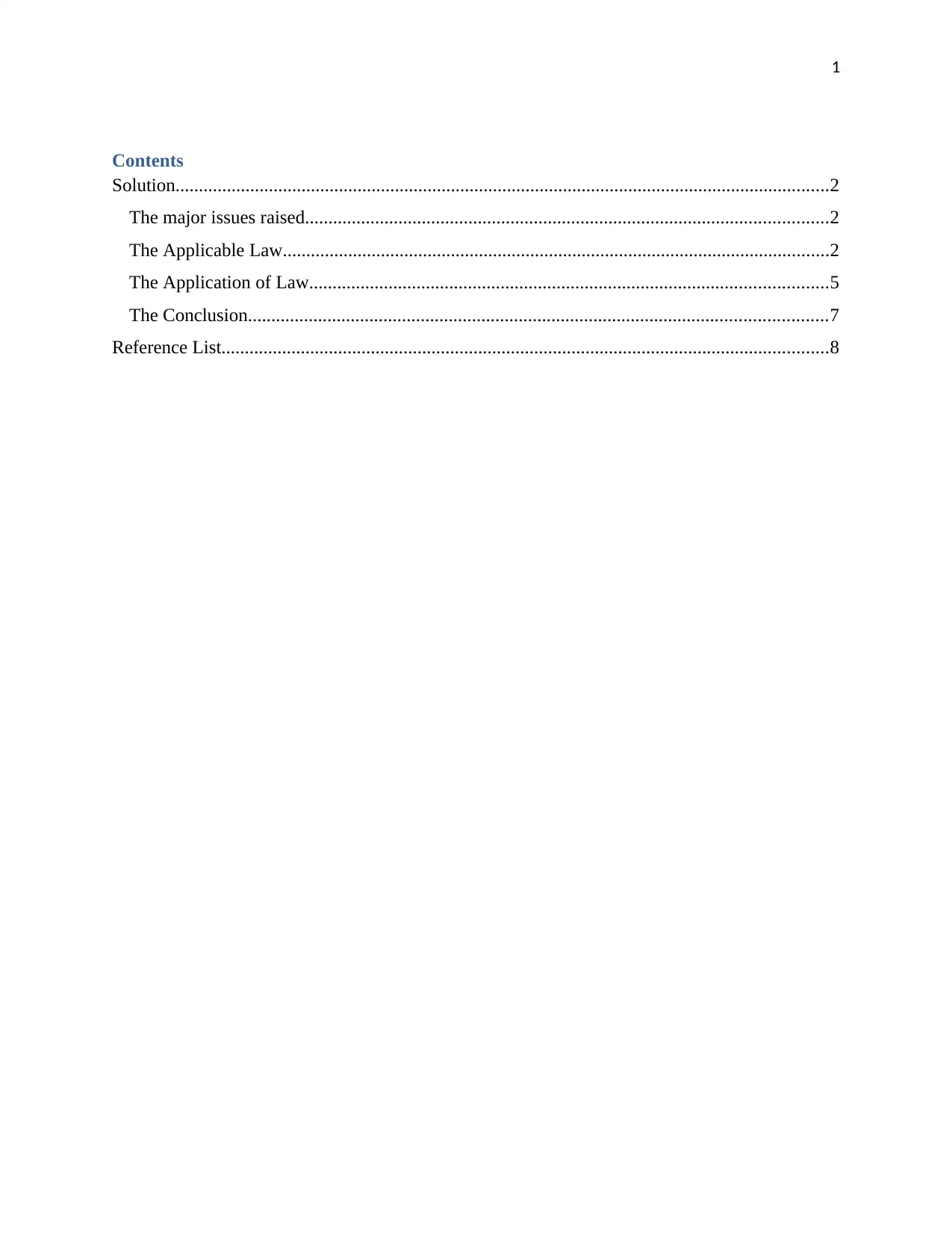
1
Contents
Solution............................................................................................................................................2
The major issues raised................................................................................................................2
The Applicable Law.....................................................................................................................2
The Application of Law...............................................................................................................5
The Conclusion............................................................................................................................7
Reference List..................................................................................................................................8
Contents
Solution............................................................................................................................................2
The major issues raised................................................................................................................2
The Applicable Law.....................................................................................................................2
The Application of Law...............................................................................................................5
The Conclusion............................................................................................................................7
Reference List..................................................................................................................................8
Secure Best Marks with AI Grader
Need help grading? Try our AI Grader for instant feedback on your assignments.
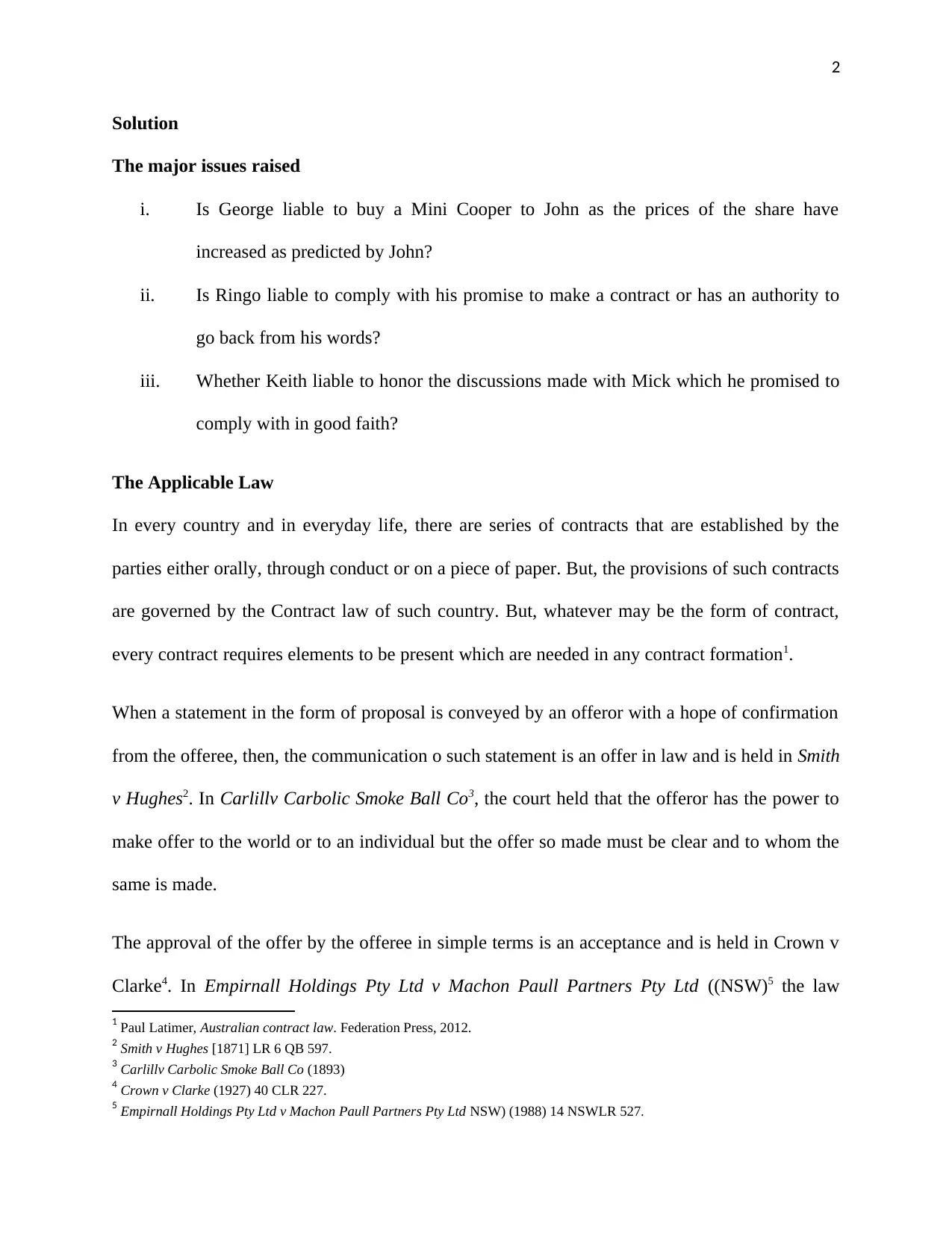
2
Solution
The major issues raised
i. Is George liable to buy a Mini Cooper to John as the prices of the share have
increased as predicted by John?
ii. Is Ringo liable to comply with his promise to make a contract or has an authority to
go back from his words?
iii. Whether Keith liable to honor the discussions made with Mick which he promised to
comply with in good faith?
The Applicable Law
In every country and in everyday life, there are series of contracts that are established by the
parties either orally, through conduct or on a piece of paper. But, the provisions of such contracts
are governed by the Contract law of such country. But, whatever may be the form of contract,
every contract requires elements to be present which are needed in any contract formation1.
When a statement in the form of proposal is conveyed by an offeror with a hope of confirmation
from the offeree, then, the communication o such statement is an offer in law and is held in Smith
v Hughes2. In Carlillv Carbolic Smoke Ball Co3, the court held that the offeror has the power to
make offer to the world or to an individual but the offer so made must be clear and to whom the
same is made.
The approval of the offer by the offeree in simple terms is an acceptance and is held in Crown v
Clarke4. In Empirnall Holdings Pty Ltd v Machon Paull Partners Pty Ltd ((NSW)5 the law
1 Paul Latimer, Australian contract law. Federation Press, 2012.
2 Smith v Hughes [1871] LR 6 QB 597.
3 Carlillv Carbolic Smoke Ball Co (1893)
4 Crown v Clarke (1927) 40 CLR 227.
5 Empirnall Holdings Pty Ltd v Machon Paull Partners Pty Ltd NSW) (1988) 14 NSWLR 527.
Solution
The major issues raised
i. Is George liable to buy a Mini Cooper to John as the prices of the share have
increased as predicted by John?
ii. Is Ringo liable to comply with his promise to make a contract or has an authority to
go back from his words?
iii. Whether Keith liable to honor the discussions made with Mick which he promised to
comply with in good faith?
The Applicable Law
In every country and in everyday life, there are series of contracts that are established by the
parties either orally, through conduct or on a piece of paper. But, the provisions of such contracts
are governed by the Contract law of such country. But, whatever may be the form of contract,
every contract requires elements to be present which are needed in any contract formation1.
When a statement in the form of proposal is conveyed by an offeror with a hope of confirmation
from the offeree, then, the communication o such statement is an offer in law and is held in Smith
v Hughes2. In Carlillv Carbolic Smoke Ball Co3, the court held that the offeror has the power to
make offer to the world or to an individual but the offer so made must be clear and to whom the
same is made.
The approval of the offer by the offeree in simple terms is an acceptance and is held in Crown v
Clarke4. In Empirnall Holdings Pty Ltd v Machon Paull Partners Pty Ltd ((NSW)5 the law
1 Paul Latimer, Australian contract law. Federation Press, 2012.
2 Smith v Hughes [1871] LR 6 QB 597.
3 Carlillv Carbolic Smoke Ball Co (1893)
4 Crown v Clarke (1927) 40 CLR 227.
5 Empirnall Holdings Pty Ltd v Machon Paull Partners Pty Ltd NSW) (1988) 14 NSWLR 527.
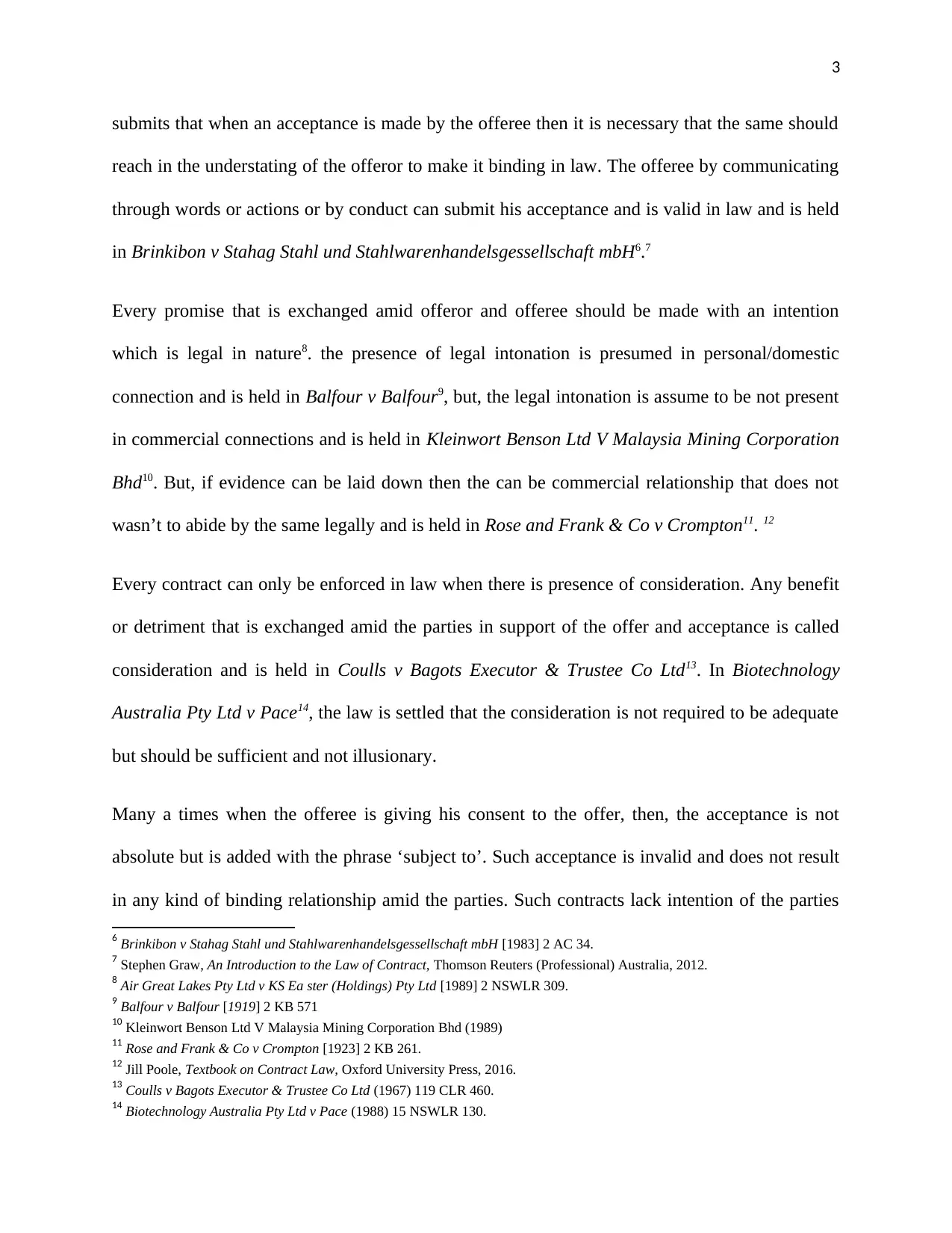
3
submits that when an acceptance is made by the offeree then it is necessary that the same should
reach in the understating of the offeror to make it binding in law. The offeree by communicating
through words or actions or by conduct can submit his acceptance and is valid in law and is held
in Brinkibon v Stahag Stahl und Stahlwarenhandelsgessellschaft mbH6.7
Every promise that is exchanged amid offeror and offeree should be made with an intention
which is legal in nature8. the presence of legal intonation is presumed in personal/domestic
connection and is held in Balfour v Balfour9, but, the legal intonation is assume to be not present
in commercial connections and is held in Kleinwort Benson Ltd V Malaysia Mining Corporation
Bhd10. But, if evidence can be laid down then the can be commercial relationship that does not
wasn’t to abide by the same legally and is held in Rose and Frank & Co v Crompton11. 12
Every contract can only be enforced in law when there is presence of consideration. Any benefit
or detriment that is exchanged amid the parties in support of the offer and acceptance is called
consideration and is held in Coulls v Bagots Executor & Trustee Co Ltd13. In Biotechnology
Australia Pty Ltd v Pace14, the law is settled that the consideration is not required to be adequate
but should be sufficient and not illusionary.
Many a times when the offeree is giving his consent to the offer, then, the acceptance is not
absolute but is added with the phrase ‘subject to’. Such acceptance is invalid and does not result
in any kind of binding relationship amid the parties. Such contracts lack intention of the parties
6 Brinkibon v Stahag Stahl und Stahlwarenhandelsgessellschaft mbH [1983] 2 AC 34.
7 Stephen Graw, An Introduction to the Law of Contract, Thomson Reuters (Professional) Australia, 2012.
8 Air Great Lakes Pty Ltd v KS Ea ster (Holdings) Pty Ltd [1989] 2 NSWLR 309.
9 Balfour v Balfour [1919] 2 KB 571
10 Kleinwort Benson Ltd V Malaysia Mining Corporation Bhd (1989)
11 Rose and Frank & Co v Crompton [1923] 2 KB 261.
12 Jill Poole, Textbook on Contract Law, Oxford University Press, 2016.
13 Coulls v Bagots Executor & Trustee Co Ltd (1967) 119 CLR 460.
14 Biotechnology Australia Pty Ltd v Pace (1988) 15 NSWLR 130.
submits that when an acceptance is made by the offeree then it is necessary that the same should
reach in the understating of the offeror to make it binding in law. The offeree by communicating
through words or actions or by conduct can submit his acceptance and is valid in law and is held
in Brinkibon v Stahag Stahl und Stahlwarenhandelsgessellschaft mbH6.7
Every promise that is exchanged amid offeror and offeree should be made with an intention
which is legal in nature8. the presence of legal intonation is presumed in personal/domestic
connection and is held in Balfour v Balfour9, but, the legal intonation is assume to be not present
in commercial connections and is held in Kleinwort Benson Ltd V Malaysia Mining Corporation
Bhd10. But, if evidence can be laid down then the can be commercial relationship that does not
wasn’t to abide by the same legally and is held in Rose and Frank & Co v Crompton11. 12
Every contract can only be enforced in law when there is presence of consideration. Any benefit
or detriment that is exchanged amid the parties in support of the offer and acceptance is called
consideration and is held in Coulls v Bagots Executor & Trustee Co Ltd13. In Biotechnology
Australia Pty Ltd v Pace14, the law is settled that the consideration is not required to be adequate
but should be sufficient and not illusionary.
Many a times when the offeree is giving his consent to the offer, then, the acceptance is not
absolute but is added with the phrase ‘subject to’. Such acceptance is invalid and does not result
in any kind of binding relationship amid the parties. Such contracts lack intention of the parties
6 Brinkibon v Stahag Stahl und Stahlwarenhandelsgessellschaft mbH [1983] 2 AC 34.
7 Stephen Graw, An Introduction to the Law of Contract, Thomson Reuters (Professional) Australia, 2012.
8 Air Great Lakes Pty Ltd v KS Ea ster (Holdings) Pty Ltd [1989] 2 NSWLR 309.
9 Balfour v Balfour [1919] 2 KB 571
10 Kleinwort Benson Ltd V Malaysia Mining Corporation Bhd (1989)
11 Rose and Frank & Co v Crompton [1923] 2 KB 261.
12 Jill Poole, Textbook on Contract Law, Oxford University Press, 2016.
13 Coulls v Bagots Executor & Trustee Co Ltd (1967) 119 CLR 460.
14 Biotechnology Australia Pty Ltd v Pace (1988) 15 NSWLR 130.
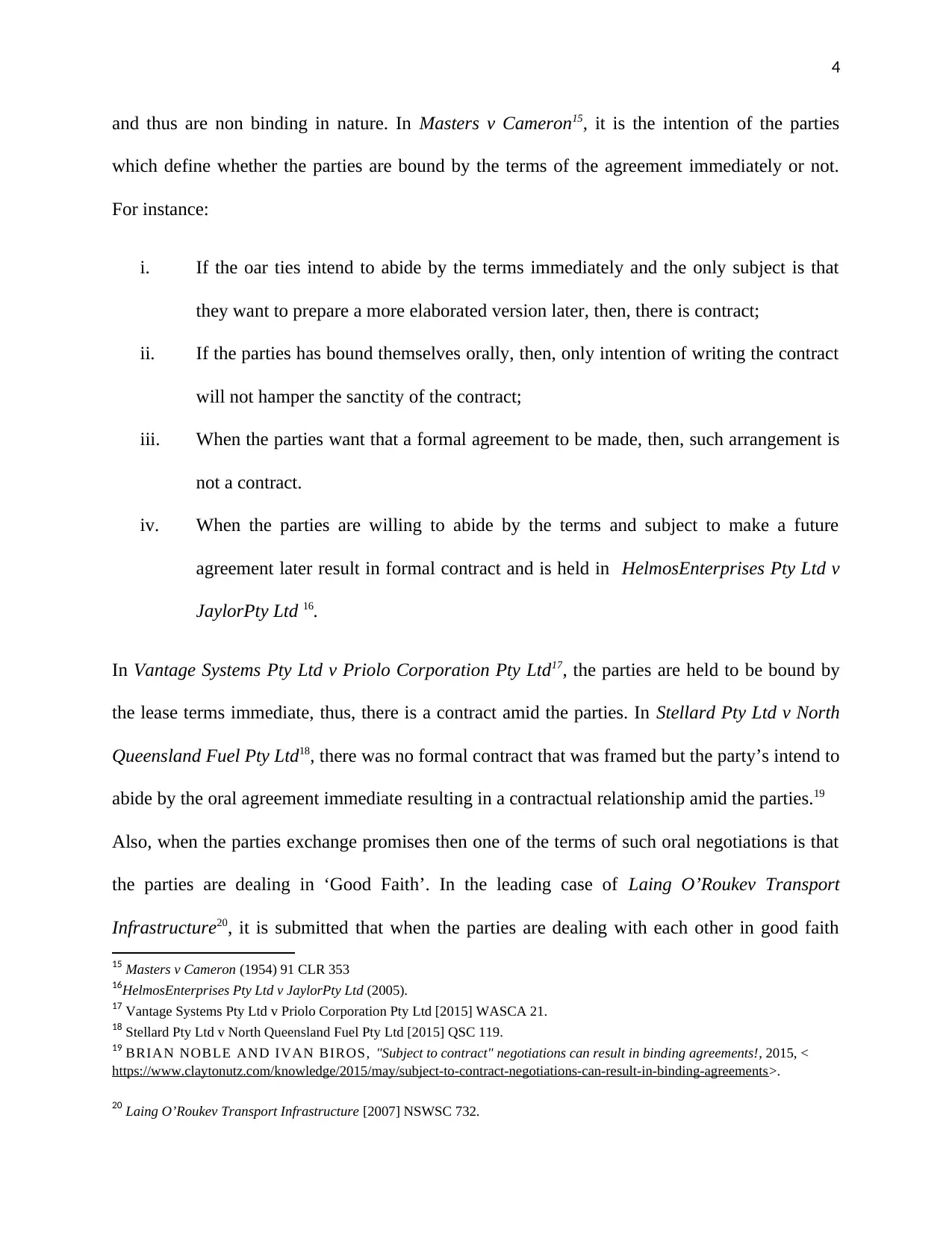
4
and thus are non binding in nature. In Masters v Cameron15, it is the intention of the parties
which define whether the parties are bound by the terms of the agreement immediately or not.
For instance:
i. If the oar ties intend to abide by the terms immediately and the only subject is that
they want to prepare a more elaborated version later, then, there is contract;
ii. If the parties has bound themselves orally, then, only intention of writing the contract
will not hamper the sanctity of the contract;
iii. When the parties want that a formal agreement to be made, then, such arrangement is
not a contract.
iv. When the parties are willing to abide by the terms and subject to make a future
agreement later result in formal contract and is held in HelmosEnterprises Pty Ltd v
JaylorPty Ltd 16.
In Vantage Systems Pty Ltd v Priolo Corporation Pty Ltd17, the parties are held to be bound by
the lease terms immediate, thus, there is a contract amid the parties. In Stellard Pty Ltd v North
Queensland Fuel Pty Ltd18, there was no formal contract that was framed but the party’s intend to
abide by the oral agreement immediate resulting in a contractual relationship amid the parties.19
Also, when the parties exchange promises then one of the terms of such oral negotiations is that
the parties are dealing in ‘Good Faith’. In the leading case of Laing O’Roukev Transport
Infrastructure20, it is submitted that when the parties are dealing with each other in good faith
15 Masters v Cameron (1954) 91 CLR 353
16HelmosEnterprises Pty Ltd v JaylorPty Ltd (2005).
17 Vantage Systems Pty Ltd v Priolo Corporation Pty Ltd [2015] WASCA 21.
18 Stellard Pty Ltd v North Queensland Fuel Pty Ltd [2015] QSC 119.
19 BRIAN NOBLE AND IVAN BIROS, "Subject to contract" negotiations can result in binding agreements!, 2015, <
https://www.claytonutz.com/knowledge/2015/may/subject-to-contract-negotiations-can-result-in-binding-agreements>.
20 Laing O’Roukev Transport Infrastructure [2007] NSWSC 732.
and thus are non binding in nature. In Masters v Cameron15, it is the intention of the parties
which define whether the parties are bound by the terms of the agreement immediately or not.
For instance:
i. If the oar ties intend to abide by the terms immediately and the only subject is that
they want to prepare a more elaborated version later, then, there is contract;
ii. If the parties has bound themselves orally, then, only intention of writing the contract
will not hamper the sanctity of the contract;
iii. When the parties want that a formal agreement to be made, then, such arrangement is
not a contract.
iv. When the parties are willing to abide by the terms and subject to make a future
agreement later result in formal contract and is held in HelmosEnterprises Pty Ltd v
JaylorPty Ltd 16.
In Vantage Systems Pty Ltd v Priolo Corporation Pty Ltd17, the parties are held to be bound by
the lease terms immediate, thus, there is a contract amid the parties. In Stellard Pty Ltd v North
Queensland Fuel Pty Ltd18, there was no formal contract that was framed but the party’s intend to
abide by the oral agreement immediate resulting in a contractual relationship amid the parties.19
Also, when the parties exchange promises then one of the terms of such oral negotiations is that
the parties are dealing in ‘Good Faith’. In the leading case of Laing O’Roukev Transport
Infrastructure20, it is submitted that when the parties are dealing with each other in good faith
15 Masters v Cameron (1954) 91 CLR 353
16HelmosEnterprises Pty Ltd v JaylorPty Ltd (2005).
17 Vantage Systems Pty Ltd v Priolo Corporation Pty Ltd [2015] WASCA 21.
18 Stellard Pty Ltd v North Queensland Fuel Pty Ltd [2015] QSC 119.
19 BRIAN NOBLE AND IVAN BIROS, "Subject to contract" negotiations can result in binding agreements!, 2015, <
https://www.claytonutz.com/knowledge/2015/may/subject-to-contract-negotiations-can-result-in-binding-agreements>.
20 Laing O’Roukev Transport Infrastructure [2007] NSWSC 732.
Secure Best Marks with AI Grader
Need help grading? Try our AI Grader for instant feedback on your assignments.
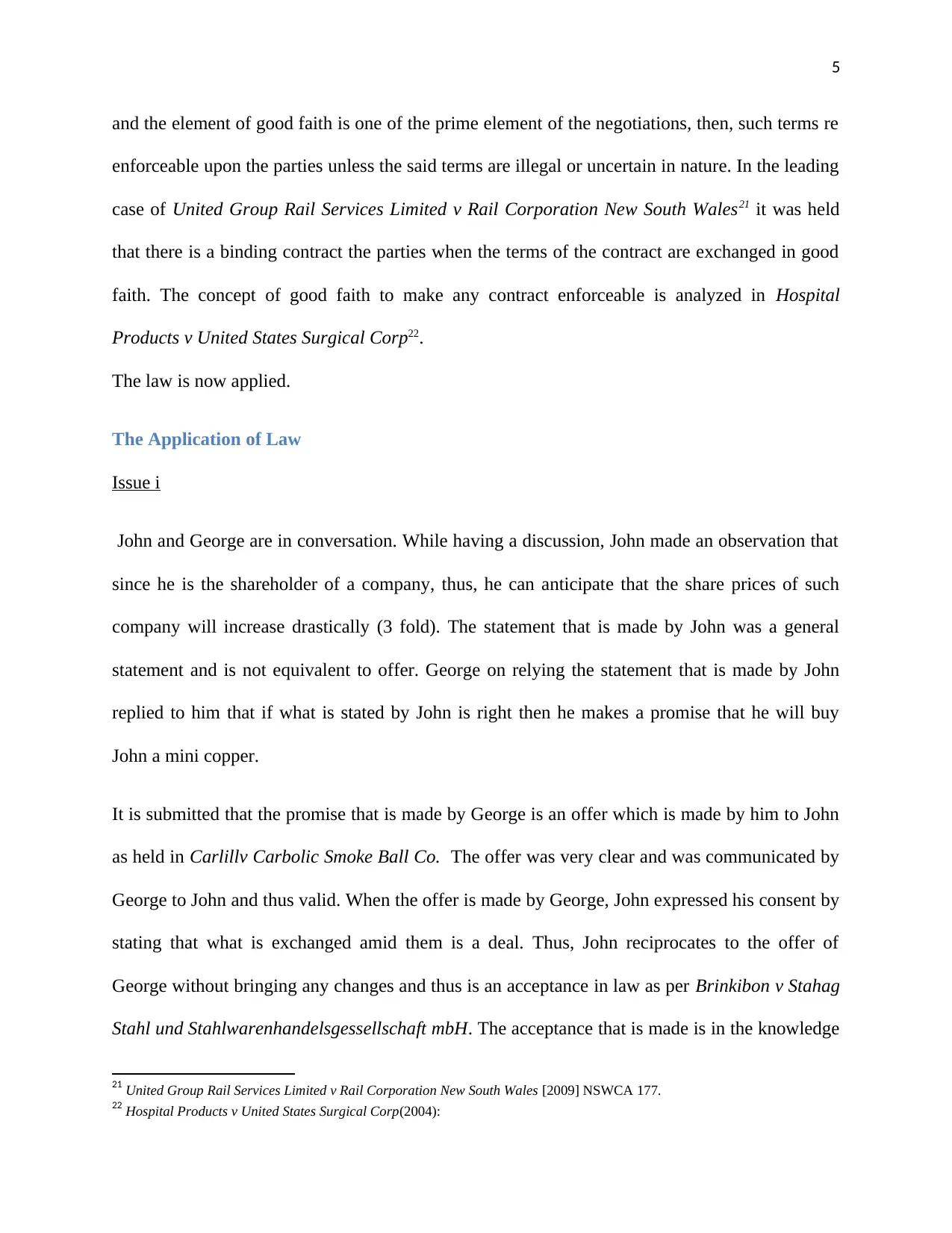
5
and the element of good faith is one of the prime element of the negotiations, then, such terms re
enforceable upon the parties unless the said terms are illegal or uncertain in nature. In the leading
case of United Group Rail Services Limited v Rail Corporation New South Wales21 it was held
that there is a binding contract the parties when the terms of the contract are exchanged in good
faith. The concept of good faith to make any contract enforceable is analyzed in Hospital
Products v United States Surgical Corp22.
The law is now applied.
The Application of Law
Issue i
John and George are in conversation. While having a discussion, John made an observation that
since he is the shareholder of a company, thus, he can anticipate that the share prices of such
company will increase drastically (3 fold). The statement that is made by John was a general
statement and is not equivalent to offer. George on relying the statement that is made by John
replied to him that if what is stated by John is right then he makes a promise that he will buy
John a mini copper.
It is submitted that the promise that is made by George is an offer which is made by him to John
as held in Carlillv Carbolic Smoke Ball Co. The offer was very clear and was communicated by
George to John and thus valid. When the offer is made by George, John expressed his consent by
stating that what is exchanged amid them is a deal. Thus, John reciprocates to the offer of
George without bringing any changes and thus is an acceptance in law as per Brinkibon v Stahag
Stahl und Stahlwarenhandelsgessellschaft mbH. The acceptance that is made is in the knowledge
21 United Group Rail Services Limited v Rail Corporation New South Wales [2009] NSWCA 177.
22 Hospital Products v United States Surgical Corp(2004):
and the element of good faith is one of the prime element of the negotiations, then, such terms re
enforceable upon the parties unless the said terms are illegal or uncertain in nature. In the leading
case of United Group Rail Services Limited v Rail Corporation New South Wales21 it was held
that there is a binding contract the parties when the terms of the contract are exchanged in good
faith. The concept of good faith to make any contract enforceable is analyzed in Hospital
Products v United States Surgical Corp22.
The law is now applied.
The Application of Law
Issue i
John and George are in conversation. While having a discussion, John made an observation that
since he is the shareholder of a company, thus, he can anticipate that the share prices of such
company will increase drastically (3 fold). The statement that is made by John was a general
statement and is not equivalent to offer. George on relying the statement that is made by John
replied to him that if what is stated by John is right then he makes a promise that he will buy
John a mini copper.
It is submitted that the promise that is made by George is an offer which is made by him to John
as held in Carlillv Carbolic Smoke Ball Co. The offer was very clear and was communicated by
George to John and thus valid. When the offer is made by George, John expressed his consent by
stating that what is exchanged amid them is a deal. Thus, John reciprocates to the offer of
George without bringing any changes and thus is an acceptance in law as per Brinkibon v Stahag
Stahl und Stahlwarenhandelsgessellschaft mbH. The acceptance that is made is in the knowledge
21 United Group Rail Services Limited v Rail Corporation New South Wales [2009] NSWCA 177.
22 Hospital Products v United States Surgical Corp(2004):
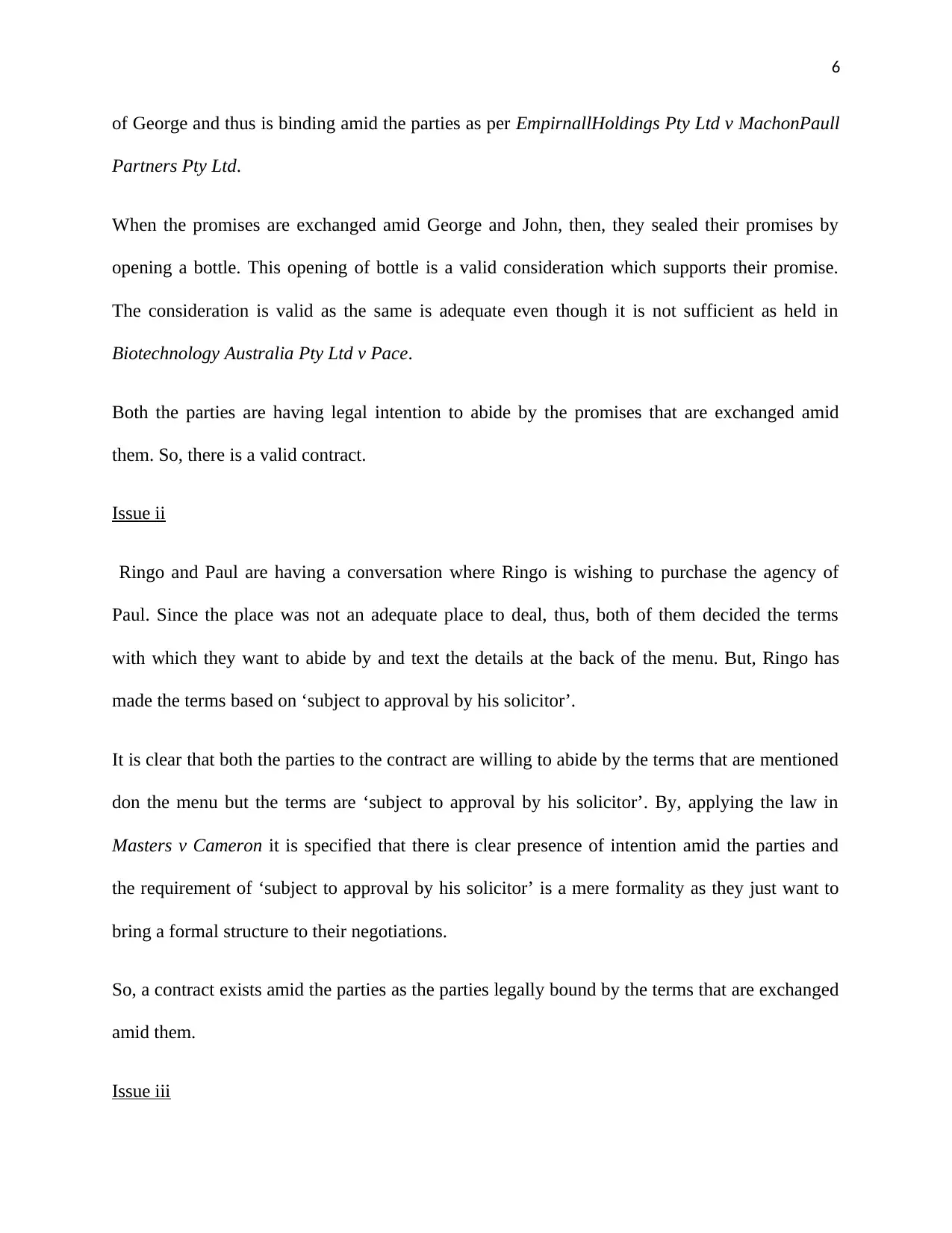
6
of George and thus is binding amid the parties as per EmpirnallHoldings Pty Ltd v MachonPaull
Partners Pty Ltd.
When the promises are exchanged amid George and John, then, they sealed their promises by
opening a bottle. This opening of bottle is a valid consideration which supports their promise.
The consideration is valid as the same is adequate even though it is not sufficient as held in
Biotechnology Australia Pty Ltd v Pace.
Both the parties are having legal intention to abide by the promises that are exchanged amid
them. So, there is a valid contract.
Issue ii
Ringo and Paul are having a conversation where Ringo is wishing to purchase the agency of
Paul. Since the place was not an adequate place to deal, thus, both of them decided the terms
with which they want to abide by and text the details at the back of the menu. But, Ringo has
made the terms based on ‘subject to approval by his solicitor’.
It is clear that both the parties to the contract are willing to abide by the terms that are mentioned
don the menu but the terms are ‘subject to approval by his solicitor’. By, applying the law in
Masters v Cameron it is specified that there is clear presence of intention amid the parties and
the requirement of ‘subject to approval by his solicitor’ is a mere formality as they just want to
bring a formal structure to their negotiations.
So, a contract exists amid the parties as the parties legally bound by the terms that are exchanged
amid them.
Issue iii
of George and thus is binding amid the parties as per EmpirnallHoldings Pty Ltd v MachonPaull
Partners Pty Ltd.
When the promises are exchanged amid George and John, then, they sealed their promises by
opening a bottle. This opening of bottle is a valid consideration which supports their promise.
The consideration is valid as the same is adequate even though it is not sufficient as held in
Biotechnology Australia Pty Ltd v Pace.
Both the parties are having legal intention to abide by the promises that are exchanged amid
them. So, there is a valid contract.
Issue ii
Ringo and Paul are having a conversation where Ringo is wishing to purchase the agency of
Paul. Since the place was not an adequate place to deal, thus, both of them decided the terms
with which they want to abide by and text the details at the back of the menu. But, Ringo has
made the terms based on ‘subject to approval by his solicitor’.
It is clear that both the parties to the contract are willing to abide by the terms that are mentioned
don the menu but the terms are ‘subject to approval by his solicitor’. By, applying the law in
Masters v Cameron it is specified that there is clear presence of intention amid the parties and
the requirement of ‘subject to approval by his solicitor’ is a mere formality as they just want to
bring a formal structure to their negotiations.
So, a contract exists amid the parties as the parties legally bound by the terms that are exchanged
amid them.
Issue iii
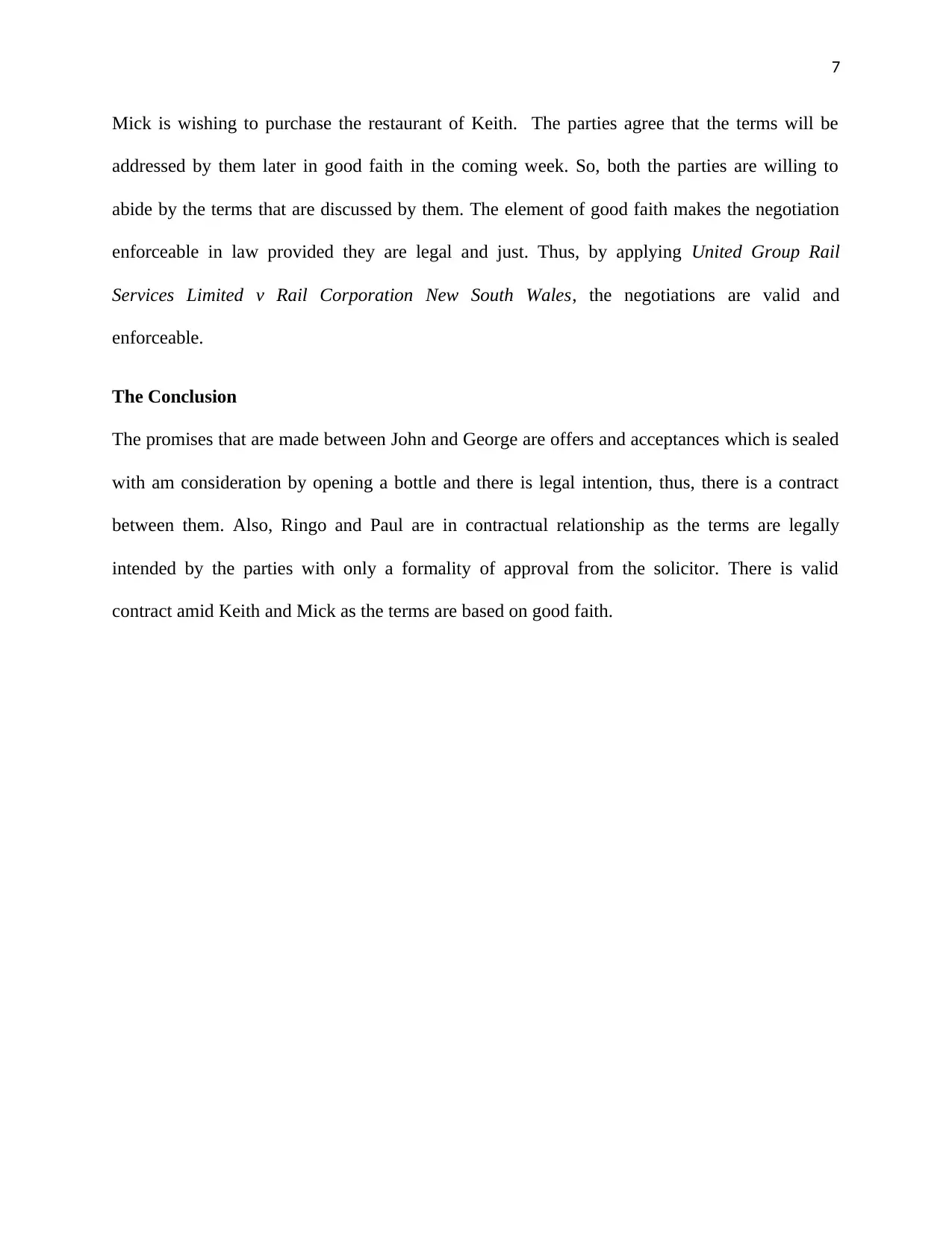
7
Mick is wishing to purchase the restaurant of Keith. The parties agree that the terms will be
addressed by them later in good faith in the coming week. So, both the parties are willing to
abide by the terms that are discussed by them. The element of good faith makes the negotiation
enforceable in law provided they are legal and just. Thus, by applying United Group Rail
Services Limited v Rail Corporation New South Wales, the negotiations are valid and
enforceable.
The Conclusion
The promises that are made between John and George are offers and acceptances which is sealed
with am consideration by opening a bottle and there is legal intention, thus, there is a contract
between them. Also, Ringo and Paul are in contractual relationship as the terms are legally
intended by the parties with only a formality of approval from the solicitor. There is valid
contract amid Keith and Mick as the terms are based on good faith.
Mick is wishing to purchase the restaurant of Keith. The parties agree that the terms will be
addressed by them later in good faith in the coming week. So, both the parties are willing to
abide by the terms that are discussed by them. The element of good faith makes the negotiation
enforceable in law provided they are legal and just. Thus, by applying United Group Rail
Services Limited v Rail Corporation New South Wales, the negotiations are valid and
enforceable.
The Conclusion
The promises that are made between John and George are offers and acceptances which is sealed
with am consideration by opening a bottle and there is legal intention, thus, there is a contract
between them. Also, Ringo and Paul are in contractual relationship as the terms are legally
intended by the parties with only a formality of approval from the solicitor. There is valid
contract amid Keith and Mick as the terms are based on good faith.
Paraphrase This Document
Need a fresh take? Get an instant paraphrase of this document with our AI Paraphraser
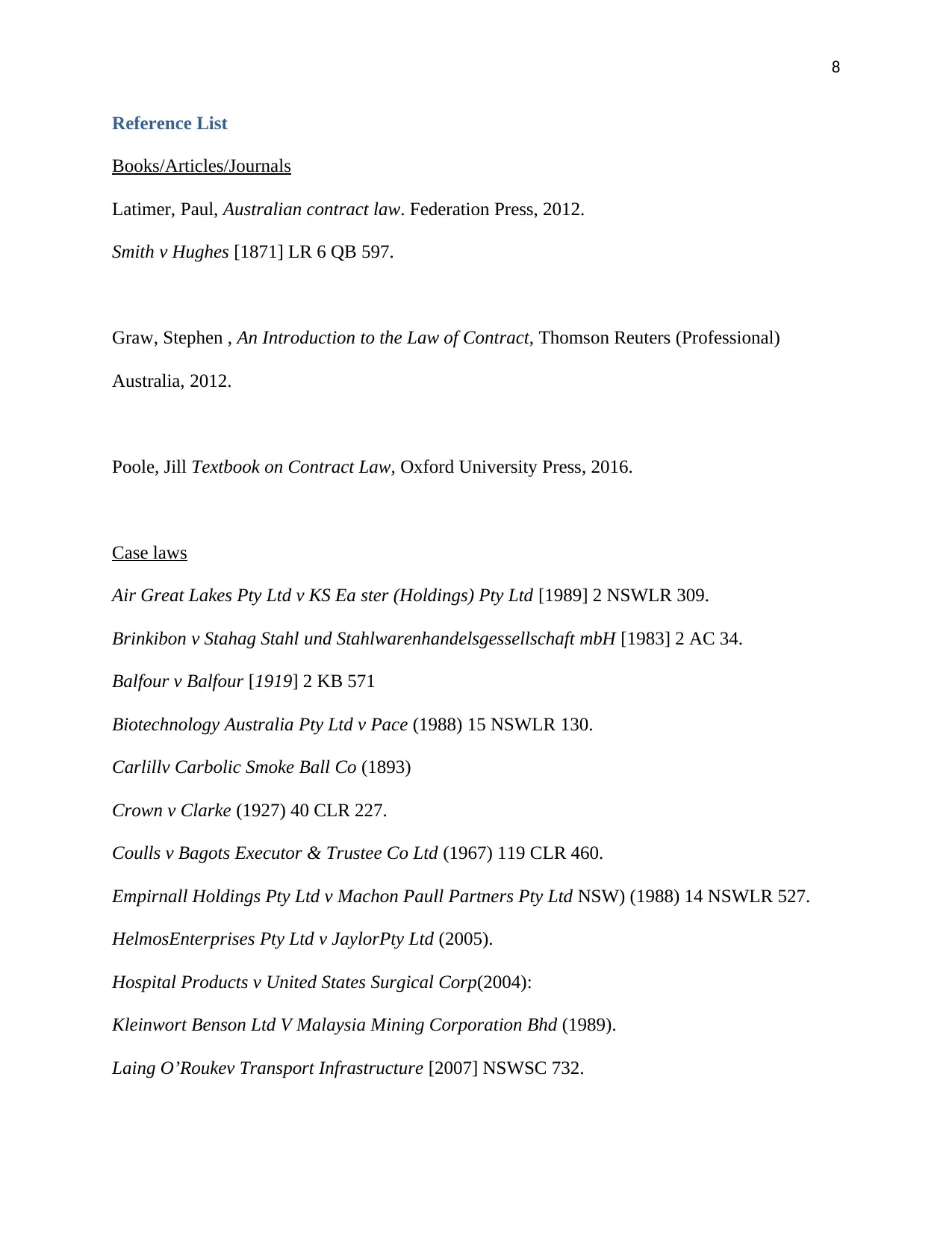
8
Reference List
Books/Articles/Journals
Latimer, Paul, Australian contract law. Federation Press, 2012.
Smith v Hughes [1871] LR 6 QB 597.
Graw, Stephen , An Introduction to the Law of Contract, Thomson Reuters (Professional)
Australia, 2012.
Poole, Jill Textbook on Contract Law, Oxford University Press, 2016.
Case laws
Air Great Lakes Pty Ltd v KS Ea ster (Holdings) Pty Ltd [1989] 2 NSWLR 309.
Brinkibon v Stahag Stahl und Stahlwarenhandelsgessellschaft mbH [1983] 2 AC 34.
Balfour v Balfour [1919] 2 KB 571
Biotechnology Australia Pty Ltd v Pace (1988) 15 NSWLR 130.
Carlillv Carbolic Smoke Ball Co (1893)
Crown v Clarke (1927) 40 CLR 227.
Coulls v Bagots Executor & Trustee Co Ltd (1967) 119 CLR 460.
Empirnall Holdings Pty Ltd v Machon Paull Partners Pty Ltd NSW) (1988) 14 NSWLR 527.
HelmosEnterprises Pty Ltd v JaylorPty Ltd (2005).
Hospital Products v United States Surgical Corp(2004):
Kleinwort Benson Ltd V Malaysia Mining Corporation Bhd (1989).
Laing O’Roukev Transport Infrastructure [2007] NSWSC 732.
Reference List
Books/Articles/Journals
Latimer, Paul, Australian contract law. Federation Press, 2012.
Smith v Hughes [1871] LR 6 QB 597.
Graw, Stephen , An Introduction to the Law of Contract, Thomson Reuters (Professional)
Australia, 2012.
Poole, Jill Textbook on Contract Law, Oxford University Press, 2016.
Case laws
Air Great Lakes Pty Ltd v KS Ea ster (Holdings) Pty Ltd [1989] 2 NSWLR 309.
Brinkibon v Stahag Stahl und Stahlwarenhandelsgessellschaft mbH [1983] 2 AC 34.
Balfour v Balfour [1919] 2 KB 571
Biotechnology Australia Pty Ltd v Pace (1988) 15 NSWLR 130.
Carlillv Carbolic Smoke Ball Co (1893)
Crown v Clarke (1927) 40 CLR 227.
Coulls v Bagots Executor & Trustee Co Ltd (1967) 119 CLR 460.
Empirnall Holdings Pty Ltd v Machon Paull Partners Pty Ltd NSW) (1988) 14 NSWLR 527.
HelmosEnterprises Pty Ltd v JaylorPty Ltd (2005).
Hospital Products v United States Surgical Corp(2004):
Kleinwort Benson Ltd V Malaysia Mining Corporation Bhd (1989).
Laing O’Roukev Transport Infrastructure [2007] NSWSC 732.

9
Stellard Pty Ltd v North Queensland Fuel Pty Ltd [2015] QSC 119.
Masters v Cameron (1954) 91 CLR 353;
Vantage Systems Pty Ltd v Priolo Corporation Pty Ltd [2015] WASCA 21.
United Group Rail Services Limited v Rail Corporation New South Wales [2009] NSWCA 177.
ONLINE MATERIAL
BRIAN NOBLE AND IVAN BIROS, "Subject to contract" negotiations can result in
binding agreements!, 2015, < https://www.claytonutz.com/knowledge/2015/may/subject-to-
contract-negotiations-can-result-in-binding-agreements>.
Stellard Pty Ltd v North Queensland Fuel Pty Ltd [2015] QSC 119.
Masters v Cameron (1954) 91 CLR 353;
Vantage Systems Pty Ltd v Priolo Corporation Pty Ltd [2015] WASCA 21.
United Group Rail Services Limited v Rail Corporation New South Wales [2009] NSWCA 177.
ONLINE MATERIAL
BRIAN NOBLE AND IVAN BIROS, "Subject to contract" negotiations can result in
binding agreements!, 2015, < https://www.claytonutz.com/knowledge/2015/may/subject-to-
contract-negotiations-can-result-in-binding-agreements>.
1 out of 9
Related Documents
Your All-in-One AI-Powered Toolkit for Academic Success.
+13062052269
info@desklib.com
Available 24*7 on WhatsApp / Email
![[object Object]](/_next/static/media/star-bottom.7253800d.svg)
Unlock your academic potential
© 2024 | Zucol Services PVT LTD | All rights reserved.




